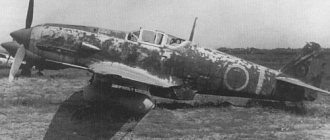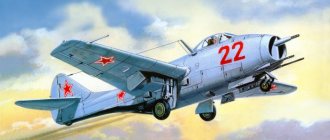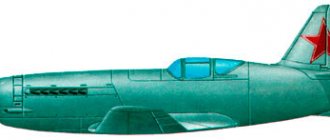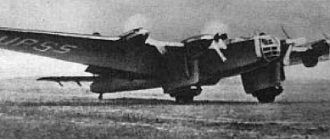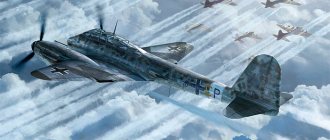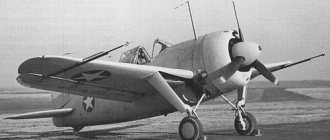The history of the creation of the Ki-100 fighter
Japanese air combat doctrine before World War II could be simplified into a simple formula: the most experienced pilots possible, in the most maneuverable aircraft possible. However, if the training of pilots in the Land of the Rising Sun was somehow managed, then problems arose with the “best” aircraft.
The main problem was the same as that of the Soviet Union: there were not enough powerful engines. But, if the USSR had to solve this problem on its own, then the Japanese managed to purchase from allied Germany in 1938 the extremely successful Daimler-Benz DB-601A , the same as on the Bf-109 fighter, and master its production under the Ha- 40 .
Since they already had experience in creating combat aircraft based on German engines (the Ki-10 fighter used the BMW-VI), it was she who was entrusted with the creation of two types of new aircraft at once: a heavy high-speed cannon interceptor and a light general-purpose fighter.
Japanese fighter and German engine
Both projects were developed by the leading designer of Kawasaki, Takeo Doi : they received the designations Ki-60 and Ki-61 , respectively. The Ki-60 turned out to be completely unsuitable for air combat, but the Ki-61 turned out to be a very “peppy” fighter, at least not inferior to its peers from other countries.
Japanese fighter Ki-61 "Swallow"
The only weak point of the Ki-61 was... that same engine. The fact is that the original DB-601A was a really powerful motor, but at the same time operating at the very limit of thermal overload. The Germans dealt with the problem simply - they tried to do everything as efficiently as possible. But the Japanese industry was unable to provide the same level of quality for the licensed Ha-40; as a result, the reliability of the Ha-40 was significantly inferior to that of the DB-601A.
However, the Ki-61 fighter was put into mass production, and at that time engineers tried to improve engine parameters “on the fly”, trying out new heat transfer reduction systems one by one. In January 1944, it was possible to establish serial production of the Ha-140 engine, which was a forced version of the Ha-40, equipped with a system for injecting a water-methanol mixture into the cylinders.
This solved the problem only partially, and as a result, the production of engines began to lag considerably behind the production of Ki-61 airframes, of which almost a hundred had accumulated in just six months. In February 1945, the supply of engines stopped altogether after the US Air Force B-29 bombers struck Akashi, damaging the buildings of the Kawasaki engine plant.
...and then we put a new engine on the Ki-61 and get a completely different aircraft: the Ki-100!
The situation became critical - Japan suffered defeat after defeat, aircraft were needed like air, 275 ready-made airframes for the new Ki-61 fighters had already accumulated in the workshops, but there was nowhere to get engines for them.
Leiko O.Yu., AS No. 1 (October-December 1990)Ki-100: Attempt at revenge.
The history of this unusual aircraft dates back to the August air battles at Khalkhin Gol. The Imperial Japanese Army Air Force has always considered maneuverability to be the most important quality of a fighter, but the latest air battles at Khalkhin Gol clearly showed that even a slight superiority in speed (20-30 km/h) can be fatal for someone who had a lower speed. This is exactly what happened with the then main fighter of the Japanese Army Air Force, the Ki.27. In the initial period of the fighting at Khalkhin Gol, this fighter inflicted considerable losses on Soviet units armed with the I-16, involving Soviet fighters in close maneuver combat. However, by July, I-16 pilots had a new tactic, known in the West as “hit-and-run”, and in the USSR as “falcon strike”. In August 1939, this tactic became the main one in the battles between the Ki.27 and I-16, and now the Ki.27 suffered heavy losses.
Seeing that until recently a modern fighter had clearly lost its superiority over the enemy, the headquarters of the Imperial Army Air Force issued a number of tasks to Japanese aircraft manufacturing firms. On the one hand, the Air Force headquarters demanded the acceleration of work on the creation of two new fighters with an air-cooled engine - Ki.43 Hayabusa (Falcon) and Ki.44 Seki (Demon). New fighters were ordered from the Nakajima company, which developed the Ki.27, which also had an air-cooled engine. Subsequently, both of these aircraft were produced in large series.
On the other hand, the Air Force headquarters was haunted by the success of the German Bf.109 fighter with a Daimler-Benz liquid-cooled engine. Back in 1938, Kawasaki purchased a license for the Daimler-Benz DB-601a engine and worked on projects for two fighters for this engine. This company already had similar experience: in the 30s it mastered the mass production of the German liquid-cooled BMW-VI engine and developed a good Ki.10 fighter. It was the Kawasaki company that the Air Force headquarters commissioned to create a heavy, high-speed cannon interceptor and a lighter general-purpose fighter. Both projects were developed by the leading designer of the Kawasaki company, Takeo Doi, and were designated Ki.60 and Ki.61, respectively. Subsequently, the Ki.61 with a liquid-cooled engine became the ancestor of the Ki.100 fighter with an air-cooled engine,
And it all started quite normally. At the end of 1940, the first licensed DB-601a, called Ha.40 in Japan (“Ha” is the first syllable of the word “hatsudoki” - engine), was assembled at the Kawasaki plant in Akashi. Already in March 1941, the first prototype of the Ki.60 fighter with this engine was ready for testing. Flight tests immediately showed the complete futility of the aircraft: longitudinal instability and heavy rudders, too long a take-off run and dangerous spin characteristics, insufficient speed and poor maneuverability. There were so many defects that work on improving the Ki.60 was almost immediately stopped and the Kawasaki company devoted all its efforts to the Ki.61. By the summer of 1942, this fighter was ready for testing.
Unlike the Ki.60, the new Ki.61 Hien (Swallow) fighter turned out to be successful. During testing, the opponents of the Ki.61 in training air battles were the Ki.4Z, Ki.44, as well as the captured P-40E and the LaGG-3 captured in Manchuria. The Ki.61 demonstrated superior maneuverability over all opponents except the Ki.43, and surpassed everyone in speed. The only weak point of the Ki.61 was its engine. The fact that the DB-601a motor operates at conditions close to the limit due to thermal overloads was also known to the Germans, but they quite successfully fought this problem by increasing the level of technology. At Japanese factories, the production standard was significantly lower and the Xa.40 engine turned out to be unreliable compared to the DB-601a. Nevertheless, the Ki.61 fighter with this engine began to be built in a large series. By July 1944, 1380 Ki.61s had been produced.
The Japanese tried to improve the Xa.40 engine. In January 1944, serial production of the Xa.140 engine began, which was a forced version of the Xa.40, equipped with a system for direct injection of a water-methanol mixture into the cylinders. The engine's performance has improved, but numerous defects remain. As a result of these defects, the production of engines did not keep pace with the production of airframes for the Ki.61 fighter. By the end of 1944, there were already 98 motorless gliders, nicknamed by the Japanese “Kubinashi” - headless. In February 1945, the supply of engines stopped altogether after the US Air Force B-29 hit Akashi, which damaged all the buildings of the Kawasaki engine plant. After this raid, until the very end of the war, only 69 engines of the Xa.140 type were assembled.
Meanwhile, Kawasaki had 275 Ki.61 gliders without engines. In conditions when hostilities took place in the air over Japan itself, there was a very acute shortage of fighters, especially for the air defense system.
Anticipating increasing difficulties with the production of the Xa.40 and Xa.140 engines, the headquarters of the Imperial Army Air Force in October 1944 began discussing with Kawasaki designers the possibility of replacing the liquid-cooled engine on the Ki.61 with a simpler and more affordable air-cooled engine. It was decided to adapt the Mitsubishi Xa.112 engine for this purpose. These engines were also used on the Ki.102 high-altitude fighters, Ki.46 reconnaissance aircraft and some other aircraft.
At first, the leading designer of the Kawasaki company, Takeo Doi, thought that such a rework would take a lot of time, but there was no way out and he had to start developing a new project. The new engine was much wider than the Ki.61 fuselage and this was the main problem, since the weight of the Xa.140 engine was only 45 kg heavier than the Xa.112. The position of the center of gravity did not change, since along with the Xa.140 the water cooling radiator was also removed, which was unnecessary for the air-cooled motor. The only remaining problem was combining the wide Kha.112 with the narrow fuselage of the Ki.61.
Kawasaki Design Bureau studied four possible installation options for the Xa.112. In the first option, no smooth transition from the engine to the fuselage was envisaged, but the sharp ledge behind the hood created such resistance that this option was rejected immediately. The second option was based on the Ki.27 design, where a large-diameter engine was fitted into a narrow fuselage with a short transition section. This option also had to be abandoned, since in this case the resistance would be too great. The third option involved installing outer skin along the entire length of the fuselage, thus changing its cross-section. The connection between the Xa.112 engine and the fuselage was ideal, but the additional skin had considerable weight, and in addition required major design alterations.
As a result, the fourth option was adopted, very similar to what they did in the USSR with LaGG-3, transforming it into La-5. Like the La-5, the Ki.100 was equipped with a lightweight skin that created a streamlined interface between the engine and the fuselage and ended at the trailing edge of the wing. The design of the sub-engine frame and hood were based on the results of research in Japan on the Focke-Wulf FW.190A fighter, but the exhaust pipes on the Ki.100 were installed differently - horizontally on both sides of the fuselage - which gave a speed increase of 10-15 km/h. In early December 1944, work began on installing a new engine on three engineless Ki.61 gliders. Just seven weeks later, on February 1, 1945, the first Ki.100 took off. Another week later, the second converted aircraft took off, and on February 19, the stoppage of production of Xa.140 engines at the Akashi plant after an American raid gave a powerful impetus to the conversion of all Ki.61 airframes to Ki.100.
The new fighter received a “long” name - “type 5 army fighter model 1-ko” and a “short” name - “Ki.100-1-Ko”. The maximum speed of the Ki.100-1-Ko fell by 10-20 km/h compared to the latest Ki.61 model at all altitudes, but maneuverability and climb rate were significantly improved due to weight reduction and increased power density. Takeoff and landing characteristics have also improved. At the air base in Yokota, training battles were held with a captured P-51S, which showed the superiority of the Ki.100-1-Ko in maneuverability. The Ki.100 was also better than the Mustang in a dive, but its superior speed allowed the Mustang to leave the battle at any time. Regarding the F6F Hellcat, it was assumed that the Ki.100 was superior to it in all respects, but no joint tests were carried out - there was no captured Hellcat in a condition suitable for flight.
Apart from replacing the motor and related alterations, no significant changes were made to the design. The fuel supply remained the same, the weapons and ammunition also did not change, and the Sumitomo propeller, manufactured under license from Hamilton, was also preserved. Therefore, the production of new fighters, which began with the conversion of the Ki.61 fuselages for a new engine, continued with the installation of these engines directly on the assembly lines of the Kawasaki plant in Kagamigahara, which previously built the Hiena. By the end of June, all non-motorized gliders (about 270 in total) received Xa.112 engines. In addition, 74 new aircraft were produced, already called Ki.100-1-Otsu. The new modification had a modified canopy, providing better visibility to the rear.
The deployment of Ki.100 production was prevented by the attack of American B-29s on the plant in Kagamigahara on June 22, 1945. The plant was dilapidated, and four days later the attack was repeated and nothing remained of the workshops. Having pulled out some equipment from under the rubble, the Japanese placed it right in the nearest small fishing line. Some of the equipment was placed in an underground shelter a kilometer from the ruins of the assembly shops. In addition, the Kawasaki company had a small plant in Tsuiki, which was previously a flour mill. Both of these improvised productions produced 40 Ki.100 in July-August. By the way, at the end of July the plant in Tsuiki was also shut down by American aircraft. Thus, in total, including prototypes, 389 Ki.100 were produced, of which 271 were converted from Ki.61. All aircraft were immediately sent to combat units.
The mastery of new aircraft in the regiments proceeded very quickly, since the Ki.100 had no serious differences in piloting compared to the Hien. The Imperial Army Air Force headquarters took this into account and sent the Ki.100 to units armed with the Ki.61. The first such part was 18 Hiko Sentai. On the night of March 9-10, 1945, a formation of 279 B-29s carried out an attack on the capital of Japan, Tokyo. Dropping M-47 incendiary bombs and M-69 clusters from low altitude, the formation of bombers turned a huge area of over 40 square kilometers in the center of Tokyo into hell. 18 Hiko Sentai was able to take only one Ki.100 fighter into the air, trying to intercept American bombers along with other air defense fighters.
Gradually the number of armed Ki.100 units grew. In April he received Ki.100 244 Hiko Sentai, in May - 5 Hiko Sentai, and later 17 and 59 Hiko Sentai. In July, 111 Hiko Sentai was formed. In air battles, the Ki.100 performed well. Its armament included a 20 mm Ho-5 cannon (“ho” translated as “gun”), as well as two Ho-103 machine guns with a caliber of 12.7 mm. The cannon fired through the propeller disk and had an ammunition capacity of 200 rounds, and machine guns were installed in the wing (250 rounds each). The weapon's defect was frequent failures of the electric trigger mechanism. However, the Ki.100 was the most reliable among Japanese fighters. Japanese experts noted that all the main systems of the aircraft were practically trouble-free, although sometimes pilots complained about the poor performance of the radio station.
Ki.100 was used to solve a variety of problems. But the main ones were interception and combat with enemy fighters. In the battle on June 3, 1945, 244 Hiko Sentai announced the destruction of seven F4U Corsairs in an air battle, and in July Ki.100 from this unit collided in the air with a large group of F6F Hellkets and shot down 12 vehicles. For Corsair and Hellcat, the Ki.100 was a dangerous opponent, but when the Ki.100 met the Mustang, the roles were usually reversed. True, pilot Masashi Sumita from 18 Hiko Sentai stated after the war that “Ki.100 could fight two Mustangs at once, and its maneuverability was such that it had no problem shaking a Mustang off its tail.” However, very often the P-51 was superior in air combat, primarily due to the higher level of training of American pilots and their numerical superiority at this stage of the war. This was especially evident in the example of 111 Hiko Sentai, where all the pilots were graduates of flight schools in 1945. This unit suffered huge losses in battles with Mustangs in the Komaki area.
Another serious opponent for the Ki.100 were the B-29 Superfortresses. At altitudes up to 7000 m, the Ki.100 could catch up with the B-29 to try to strike, but at higher altitudes the fighter’s performance dropped sharply. But it was the B-29s that annoyed Japan the most. Not a week passed without large formations of these bombers knocking out several factories or destroying some city. At the end of the war, the entire Japanese aviation industry was just looking for a means against the B-29 and the ships of the US fleet, which were getting closer and closer to the islands of the mother country. They also tried to make a high-altitude interceptor from the Ki.100.
Back in March 1945, a turbocharger was installed on one of the Ki.100s at the direction of Takeo Doi. The turbine was installed under the engine and modifications to the design were minimal. There was nowhere to place an intermediate radiator and the air from the compressor went straight into the carburetor. To ensure that the engine power does not drop at altitudes below the design power, an injection of a water-methanol mixture was provided. The tank with the mixture was installed directly in the cockpit behind the pilot's seat. The Ru-102 turbocharger installed on the Ki.100 was a serial product already used on some aircraft. However, problems of a completely different kind arose.
After the main and even many auxiliary factories were destroyed by B-29 attacks, aircraft production in Japan actually proceeded at a makeshift level. In May 1945, the first Ki.100 with a supercharger began to fly and a gas leak was immediately discovered in the exhaust manifolds. It was so great that the increase in performance was less than expected. A few days later, the second and third prototypes of the new modification, called Ki.100-II, began to fly. The data obtained during flight tests of the Ki.100-II were highly unstable.
The Ki.100-II was 175 kg heavier than the Ki.100-I and the maneuverability of the new model was worse. Due to the lack of an intermediate radiator, the altitude characteristics remained limited, and at altitudes up to 7000 m the speed of the Ki.100-II was less than that of the Ki.100-I, but above 7000 m the characteristics of the Ki.100-II began to improve and at an altitude of 8000 m he had top speed. Now the Ki.100-II's chances in the fight against the B-29 were much better. It was planned to begin serial production of the Ki.100-II instead of the Ki.100-I-Otsu. The tail section of the Ki.100-II was planned to be made of wood, since there was not enough duralumin. However, until August 15, 1945, not a single production Ki.100-II was built.
Although the Ki.100 was not a mass-produced fighter during the Second World War, its history is quite interesting - after all, only 4 months passed from the inception of the idea to the first flight, and the entire life of the aircraft lasted only 10 months. Only four similar modifications were made in the world: in the USSR, the LaGG-3 was converted into the La-5 by replacing the M-105 engine with an M-82; in Germany, the air-cooled engine was replaced with a liquid-cooled engine on the Focke-Wulf 190; in England, the Hauker fighter Tempest was immediately designed for engines of different systems, and the fourth was the Kawasaki Ki.100 fighter.
Among the fighters of the Second World War, the Ki.100 occupied a worthy place.
Camouflage scheme
Ki 100-I-ko, 59th Sentai, 1945
Ki 100-I-otsu, 5th Sentai, 1945
Ki 100-I-otsu, flight school in Akeno, 1945
Ki 100-II-ko, third prototype, 1945
Blueprints
discuss on the forum
The evolution of the Ki-61 to the Ki-100 and the design features of the new fighter
Anticipating in advance the increasing difficulties with the production of the Ha-40 and Ha-140 engines, the headquarters of the Imperial Army Air Force back in October 1944 began discussing with Kawasaki designers the possibility of replacing the liquid-cooled engine on the Ki-61 with a simpler and more affordable air-cooled engine.
It was decided to adapt the Mitsubishi Ha-112 engine for this purpose. These engines were also used on the Ki-102 high-altitude fighters, Ki-46 reconnaissance aircraft and some other aircraft.
At first, the leading designer of the Kawasaki company, Takeo Doi, thought that such a rework would take a lot of time, but there was no way out and he had to start developing a new project. The new engine was much wider than the Ki-61 fuselage and this was a major problem since the Ha-140 was only 45 kg heavier than the Ha-112. The position of the center of gravity did not change, since along with the Ha-140 the water cooling radiator was removed, which was unnecessary for the air-cooled motor. The only remaining problem was combining the wide engine with the narrow fuselage.
As a result, of all the options, the Japanese liked the Soviet experience more: when, instead of the narrow “in-line” M-105 engine, the LaGG-3 fighter had to be equipped with a heavy and powerful M-82 “star”, thereby turning the LaGG-3 into a La-3. 5, to mate the unsuitable new engine with the old fuselage, the latter was simply “expanded” by installing a lightweight skin that ensured a smooth transition from the wide part to the narrow part.
The similarity between the Japanese Ki-100 and the Soviet La-5 is simply amazing
Kawasaki specialists did the same - instead of the Ha-140, they installed the Ha-112 on the Ki-61, and the resulting “protrusion” was smoothed out using metal panels that created a streamlined interface between the engine and the fuselage and ending at the trailing edge of the wing. The resulting new fighter was given a new name: Ki-100 .
The design of the sub-engine frame and hood were based on the results of research in Japan on the Focke-Wulf FW.190A fighter, but the exhaust pipes on the Ki.100 were installed differently - horizontally on both sides of the fuselage, which gave a speed increase of 10-15 km/h.
In early December 1944, work began on installing a new engine on three engineless Ki.61 gliders. Just seven weeks later, on February 1, 1945, the first Ki.100 took off. A week later, the second converted aircraft took off, and on February 19, the stoppage of production of Ha.140 engines at the Akashi plant after an American raid gave a powerful impetus to the conversion of all Ki.61 airframes to Ki.100.
Links[edit]
| Wikimedia Commons has media related to Kawasaki Ki-100 . |
Quotes [edit]
- ^ abcde Francillon, 1979, p.134
- Ethell, 1995, p.83
- Picarella, 2005, p.74
- ^ abc Picarella, 2005, pp.76–77
- Air International
, October 1976, pp.186-187 - ^ abc Picarella, 2005, pp.64–68
- ^ abc Picarella, 2005, p.69
- Picarella, 2005, p.67
- Picarella, 2005, pp.74-75
- ^ ab Francillon, 1979, p.132
- Francillon, 1979, p.130
- Sgarlato, 1996
- Picarella, 2005, p.73
- Francillon, 1979, p.395
- Milman, 2015, pp.81, 85-86
- Sakaida, 1997, p.73
- "List of USN Aircraft Lost Overseas, July 1945." . Aviation Archaeological Research and Exploration. Retrieved December 15, 2022.
- ^ ab USSBS, Appendix E., p.16
- Craven, 1953, pp.565-568
- ^ a b c d Simpson, Andrew (2012). "Custom History of Kawasaki Ki-100-1b BAPC.83/8476M, Museum Accession Number 85/AF/68" (PDF). www.rafmuseum.org.uk
. - Francillon, 1970, pp.133-134
- Gladniker, David. "An Incomplete Guide to Using an Airfoil". m-selig.ae.illinois.edu
. Retrieved April 16, 2022. - ^ a b Model Art, 1994, p.186
Characteristics of the Kawasaki Ki-100 fighter
| A country: | Japan |
| Type: | Fighter |
| Year of issue: | 1945 |
| Crew: | 1 person |
| Engine: | Mitsubishi Ha 112-II with 1500 hp |
| Maximum speed: | 580 km/h |
| Practical ceiling: | 11000 m |
| Range of flight: | 2200 km |
| Empty weight: | 2525 kg |
| Maximum take-off weight: | 3495 kg |
| Wingspan: | 12 m |
| Length: | 8.82 m |
| Height: | 3.75 m |
| Wing area: | 20 sq.m. |
| Weapons: | 2x 20mm Ho-5 cannons in the fuselage, 250 rounds per barrel and 2x 12.7mm Ho-103 machine guns in the wing, 250 rounds per barrel. |
Production of the Ki-100 fighter
The new fighter received the “long” name “ Army Fighter Type 5 ” and the “short” name Ki.100-I-Ko . The maximum speed of the Ki.100-1-Ko fell by 10-20 km/h compared to the latest Ki.61 model at all altitudes, but maneuverability and climb rate were significantly improved due to weight reduction and increased power density. Takeoff and landing characteristics have also improved.
At the airbase in Yokota, training battles were held with a captured American P-51C Mustang, which showed the superiority of the Ki.100-1-Ko in maneuverability. The Ki.100 was also better than the Mustang in a dive, but its superior speed allowed the Mustang to leave the battle at any time.
Regarding the main American carrier-based fighter F6F Hellcat, it was assumed that the Ki.100 was superior to it in all respects.
Apart from replacing the motor and related alterations, no significant changes were made to the design. The fuel supply remained the same, the weapons and ammunition also did not change, and the Sumitomo propeller, manufactured under license from Hamilton, was also preserved. Therefore, the production of new fighters, which began with the conversion of Ki.61 fuselages for a new engine, continued with the installation of these engines directly on the assembly lines of the Kawasaki plant in Kagamigahara, which previously built Hien. By the end of June, all non-motorized gliders (about 270 in total) received Ha.112 engines. In addition, 74 new aircraft were produced, already called Ki.100-1-Otsu. The new modification had a modified canopy, providing better visibility to the rear.
In total, including prototypes, 389 Ki-100s were produced, of which 271 were converted from Ki-61. All aircraft were immediately sent to combat units.
The mastery of new aircraft in the regiments proceeded very quickly, since the Ki-100 had no serious differences in piloting compared to the Ki-61. The Imperial Army Air Force Headquarters took this into account and sent the Ki-100 to units mainly armed with the Ki-61.
Drawing of the Japanese Ki-100 fighter
History of operations[edit]
The Ki-100 made its combat debut on the night of 9 March 1945 [7] and suffered its first loss a month later on the night of 7 April 1945, when the only Ki-100 of the 18th Sentai
was shot down by a B-29 Superfortress after "attacking the formation again and again." [7] Allied aircrews soon realized that they were facing a formidable new fighter. [11] Although the Ki-100 was available for much less than Nakajima's Ki-84, it was an important fighter aircraft for the army. The well-handled Ki-100 was able to outmaneuver any American fighter, including the P-51D Mustang and Republic P-47N Thunderbolts, which escorted the B-29 over Japan and was comparable in speed, especially at medium altitudes. The Ki-100 was a formidable opponent in the hands of an experienced pilot. The Ki-100, along with the Army's Nakajima Ki-84 and the Navy's Kawanishi N1K-J, were equal to the latter Allied types in the final year of the Pacific War. [12]
Army fighter units equipped with this model included the 5th, 17th, 18th, 20th, 59th, 111th, 112th, 200th and 244th Sentai
, as well as the 81st Independent Fighter Company. The pilots were trained at the Akeno and Hitachi (Mito) army flight schools. Many Akeno and Hitachi instructors were from operational wings, and between training missions they also flew combat missions, making the most of several combat fighters, but these wings were only partially re-equipped. [13]
111th Sentai
Ki-100-I-Otsu
During the interception of high-flying B-29 Superfortresses (before the B-29s switched to low-level missions), the new fighters struggled as engine power still dropped at high altitudes. The most effective strategy against the B-29 Superfortress remained the extremely dangerous frontal attack, in which the fighter remained relatively stationary in the field of view of the bomber's defensive guns, making it an easy target. In this type of combat Mitsubishi J2M Raiden
The Navy remained the best. [14]
111th Sentai
A Ki-100 intercepted B-29 Superfortresses attacking Kobe on 5 June 1945, claiming six bombers and five "probables" shot down.
The Americans recorded the loss of nine B-29s, including those shot down by Ki-100s over the affected area. A Ki-100 from the same unit joined the 244th Sentai
Ki-84 in a large-scale engagement against the 506th Fighter Group of North American P-51 Mustangs over Nagoya Bay on 16 July 1945. The Ki-100 pilots captured six P-51s and upon return, five Ki-100s were lost and three pilots killed, although American records show only one loss. [15]
July 25, 1945 18 fighters of the 244th Sentai
The Ki-100s faced 10 VF-31 Grumman F6F Hellcats from the light aircraft carrier USS Belleau Wood in a dogfight in which the Ki-100 pilots scored 12 victories and two losses. The claims and counterclaims in this lawsuit remain controversial. The Americans took two Ki-100s and admitted that they had lost two VF-31 F6F-5 Hellcats. These included a Ki-100 and a Hellcat, which collided, killing both pilots. [16] [17]
Following the bombing of the Kagamigahara plant and slow deliveries of components from satellite factories, Ki-100 performance declined and only 12 components were delivered between May and July. The bombing would end with the production of only 118 Army Type 5 Fighter Model 1b fighters.
The final flights of the Imperial Japanese Army Air Service were made by two Ki-100s flown from Komachi to Yokosuka, where they were transferred to the United States, which then sent them back to the US for evaluation. [10]
Combat use of the Ki-100 fighter
In air battles, Ki.100 fighters performed well. The aircraft's armament included a 20 mm Ho-5 cannon, as well as two Ho-103 machine guns with a caliber of 12.7 mm. The cannon fired through the propeller disk and had an ammunition capacity of 200 rounds, and machine guns were installed in the wing (250 rounds each). The weapon's defect was frequent failures of the electric trigger mechanism. However, the Ki.100 was the most reliable among Japanese fighters. Japanese experts noted that all the main systems of the aircraft were practically trouble-free, although sometimes pilots complained about the poor performance of the radio station.
Ki.100 was used to solve a variety of problems. But the main ones were interception and combat with enemy fighters. For the American Corsair and Hellcat, the Ki.100 was a dangerous opponent, but when meeting with the Mustang, the roles usually changed.
Another serious opponent for the Ki.100 was the B-29 “Superfortress”. At altitudes up to 7000 m, the Ki.100 could catch up with the B-29 to try to strike, but at higher altitudes the fighter's performance dropped sharply. Although it was planned to build the Ki-100 in the future as a high-altitude interceptor, these plans did not become a reality until the end of the war.
Surviving aircraft[edit]
- Kawasaki Ki-100-1b s/n 8476M was captured at Tan Son Nhat Airfield, Saigon, in August 1945 in airworthy condition, having only recently been delivered. [20] However, it was damaged there on 26 November 1945 during a wheel-up landing after the landing gear failed to lower while attempting to land at Bien Hoa Airfield, 15 miles away; A Japanese pilot flew him there for flight testing. [20] The oil cooler, propeller, and tailwheel were repaired but were not returned to fully serviceable condition; It was later sent to the UK along with three other Japanese aircraft, including the fuselage of the Mitsubishi A6M Zero (Zeke), the Mitsubishi Ki-46 (Dina) and the Nippon Kokusai Ki-86 (Cyprus). [20] After several years of storage in various locations and being misidentified as a Nakajima Ki-43 (Oscar), it was restored and displayed at the Royal Air Force Museum in Hendon, UK. [20] Moved to RAF Cosford Museum on 30 January 2012.
Modifications of the Ki-100 fighter
- The Ki-100 is a prototype fighter, actually a Ki-61 with the Ha-140 engine replaced by the Ha-112, and the nose of the fuselage widened to reduce aerodynamic drag.
- Ki.100-I-Ko - “serially converted” Ki-61 airframes left without “original” engines.
- Ki.100-1-Otsu is a completely independent model, originally built for the Ha-112 engine and having a modified canopy that provides better visibility to the rear.
- Ki.100-II - Ki-100 with Ru-102 turbocharger. The turbine was installed under the engine, air from the compressor went directly to the carburetor. To prevent a drop in engine power at altitudes below the design power, an injection of a water-methanol mixture was provided. The tank with the mixture was installed directly in the cockpit behind the pilot's seat. The tail section of the aircraft was supposed to be made of wood due to a lack of duralumin. At altitudes up to 7000 m, the “one hundred or two” had worse characteristics compared to the original model, but above it it was already seriously superior to it and could well fight the American “flying fortresses”. However, the production of this model was never mastered by Japan.
• Aviation Directory • Aircraft of the same period •
Source: compilation based on information publicly available on the Internet, incl. AS magazine No. 1 (October-December 1990).
